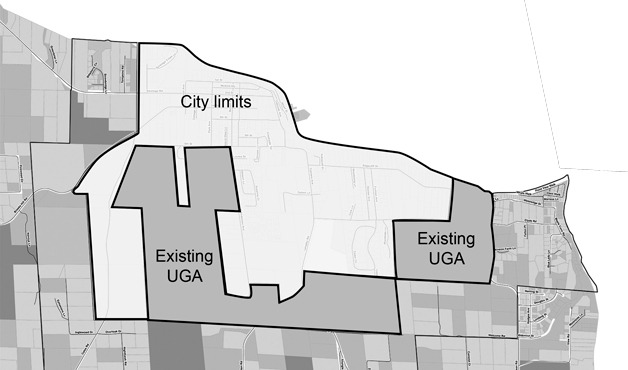Just how large the city should get is foundation for just about everything else in Langley’s comprehensive plan update, to be discussed in pieces over the next few months.
The first public input meeting about a handful of elements in the plan update is set for 6:30 p.m. Wednesday, Dec. 16. Topics to be covered include: the urban growth area reduction request, comp plan vision statement, shoreline master program, and the land use, sustainability and economic development elements.
“We’re not lacking for regulation, policies, goals, whatever,” said Jack Lynch, interim director of Langley Community Planning.
The comprehensive plan will guide growth for the next 20 years and the city is seeking public input. Evaluating and discussing a handful of elements at a time will keep the conversation focused, said Planning Advisory Board Chairwoman Sue Walsh. Separate elements prescribe unique aspects of life in Langley, from sustainability, economic development and land use to housing, capital facilities, parks, open space and trails. Utilities, transportation, scenic corridor streetscape and shoreline management will also be focuses.
The city has recommended Island County reduce Langley’s urban growth area to its city limits. The reduction is based on a state-projected population growth of 89 residents by 2036. With close to 1,050 residents now and an estimated capacity for 1,700 residents at a full buildout within city limits, that means the city already has enough room to accommodate the projected growth. What is in the existing urban growth area, which stretches well past city limits, will become a joint planning area between the city and county with an eye toward a potential growth area for Langley, should the population projections be surpassed in coming years.
“We’re coming into better compliance with what we have,” Walsh said of the urban growth area decision that she and other planning board members argued for.
Nothing new is planned for the city’s capital facilities element. The funicular remains on the list, said Lynch, because if it was removed the city would automatically forfeit the earmarked funds designated from the Island County Council of Governments. While it is on the city’s list, that does not mean it must or will be built. The city tabled talks of how to proceed with an improved connection between the marina and the city’s downtown businesses after opinions at public meetings were decidedly opposed to such a structure. It’s not a planned project, but it’s not dead.
The land use element dictates most of the zoning. According to the draft document, 70 percent of city land is designated for medium and low density residential-zoned lots. Affordable housing is becoming increasingly difficult to find in Langley, with home values averaging $353,800, according to the real estate website Zillow. One of the main factors, said both Lynch and Walsh, was the basic cost of land. In Langley, land is valuable with so much water view property.
“There’s an attractiveness to living here,” Lynch said. “But it can be tough to find a place to live.”
Of the city’s total land, about 590 acres, multi-family housing accounts for only 22.24 acres, or 17.4 percent. According to the city’s document, 21.87 acres of that land is already developed. The remaining property, just 0.37 acres, is vacant.
Vacancy is a problem for the central business district, also referred to as the downtown core, as stated in the land use element. The Dog House Tavern, the old Mike’s Place Restaurant, and a couple of other First Street vacancies dampen what is otherwise a well-filled commercial area.
“Those are significant challenges,” Walsh said.
Planning intern Doug Yormick was tasked with reviewing other cities’ ordinances for enforcing active commercial building owners. Some places fine owners who do not keep up their storefronts, even when vacant, past a lapsed time period. His research is incomplete, so he is not presenting any conclusions about what measures could work for Langley.
Reworked in the economic development element is a section describing the city’s reliance on tourism. Two goals are to: “Work with organizations such as the Chamber of Commerce, the Langley Main Street Association, and the Port of South Whidbey to continue to promote events that appeal to both residents and tourists;” and “Seek to create events to attract tourists to Langley during autumn and winter months.”
The city’s sustainability element bolstered its section titled “Community.” Defining the core values of community as working, living and shopping locally, participating in local schools, organizations, churches and events, walkability is listed as a key element to a sustainable community. According to the document, the median age in Langley is about 58 years, and “regular exercise is an essential element of a healthy and sustainable lifestyle. Access to trails and other opportunities to get about the city on foot are critical to this effort.”
Promoting a walkable community through the creation of trails in new developments and additional sidewalks was stated as a means of achieving that element’s goals. Sidewalk projects are being discussed for Sixth Street.
The planning advisory board and planning director scheduled meetings in December, January and February to present and gather input on the elements in groups, before recommending the overall document’s adoption to the city council in late February.



